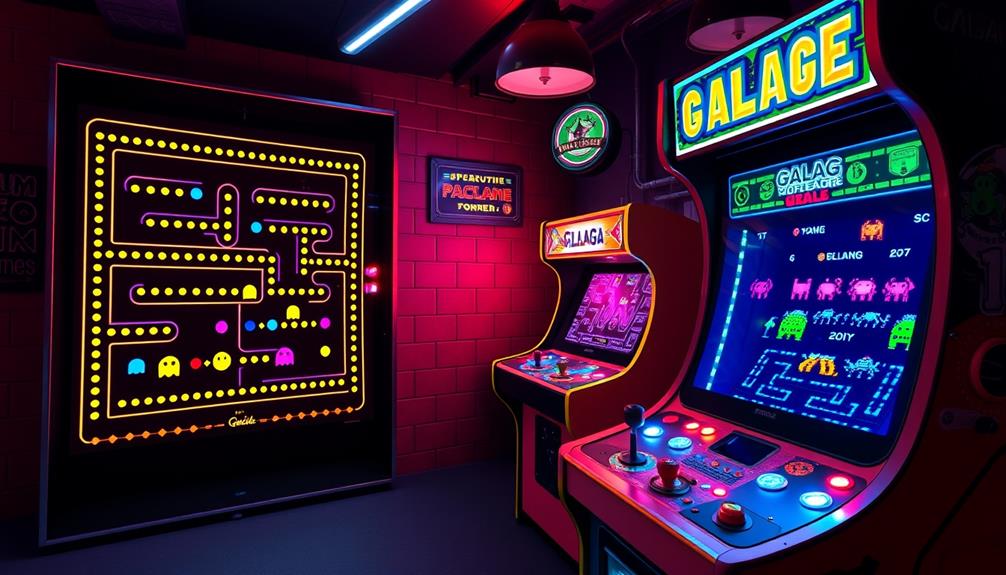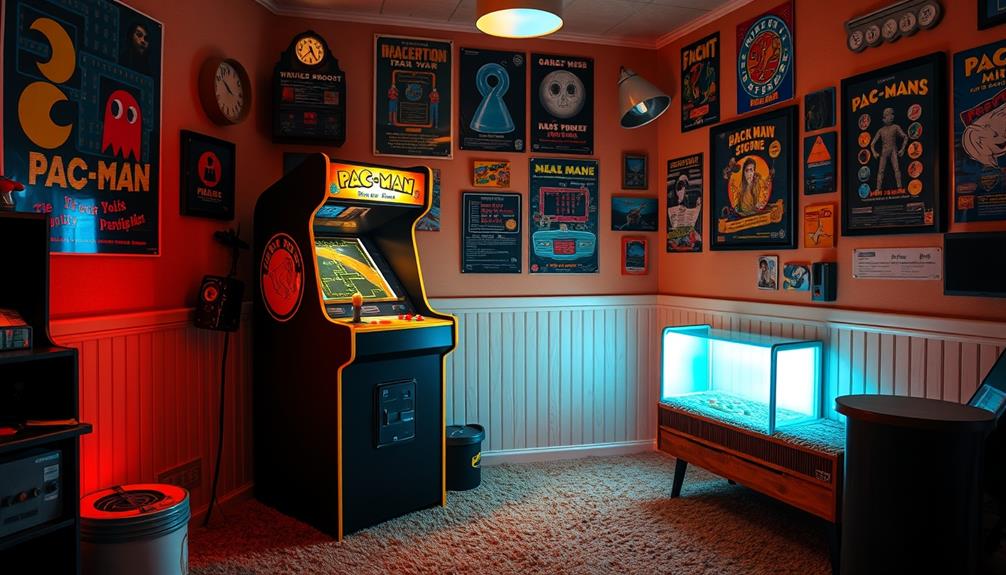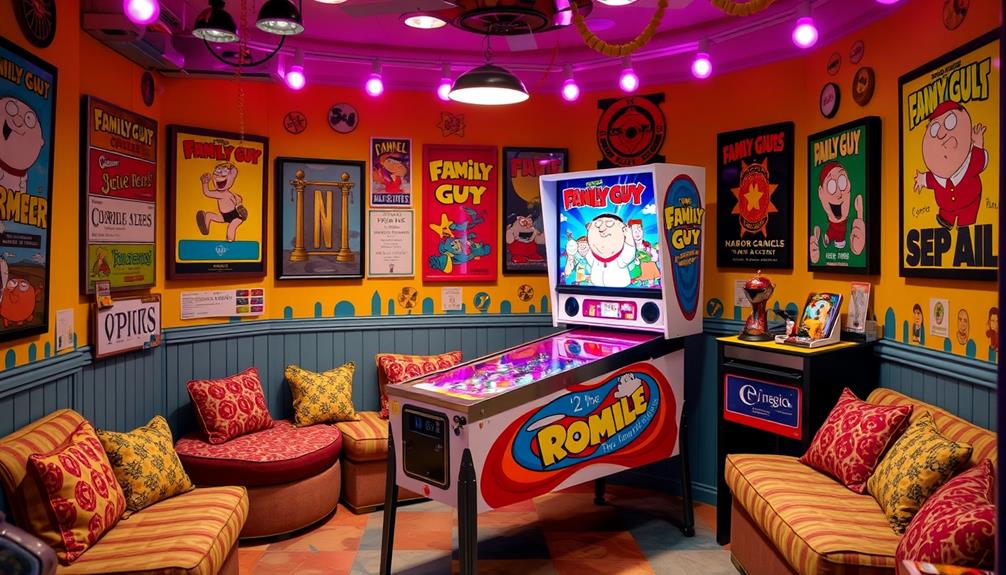Arcade games function by integrating electronic components, programming, and player interactions. When you insert a coin, the arcade cabinet powers up, bringing the game to life. Inside, the Printed Circuit Board (PCB) serves as the central processing unit, interpreting signals from controls like joysticks and buttons. Your inputs prompt actions in the game, while sound systems enhance the immersive experience. Contemporary machines often feature multiplayer capabilities, elevating competition and fostering a sense of community. As technology advances, arcade gaming continues to evolve. If you’re interested in staying up to date on the latest trends and upcoming developments, there is much more to explore! Some popular arcade games with spinner controls, such as Centipede and Tempest, require players to manipulate a spinning dial to move their character or aim their attacks. These unique controls bring an additional layer of physical engagement to the gaming experience. As arcade gaming progresses, we can anticipate more innovative and interactive ways for players to interact with their favorite games in the years to come.
Key Takeaways
- Arcade games operate through a cabinet housing essential electronics like the monitor, controls, and power supply for gameplay functionality.
- The PCB (Printed Circuit Board) functions as the brain, processing player inputs and executing game actions.
- Modern arcade machines often feature networked multiplayer capabilities, enhancing social interaction among players.
- Game programming has evolved from assembly languages to modern languages like C++, improving performance and complexity.
- Advanced technologies, such as VR and AR, are shaping the future of arcade gaming, creating more immersive experiences.
Overview of Arcade Games
Arcade games have long captivated players, particularly during their golden age from the late 1970s to early 1990s, when iconic titles like Pac-Man and Space Invaders defined gaming culture.
These coin-operated machines became staples in public venues like malls, restaurants, and entertainment centers, offering a new form of entertainment that shifted the landscape of video gaming. The evolution of arcade games was influenced by earlier gaming innovations, such as the history of pinball machines, which paved the way for the development of interactive gameplay.
At their core, arcade games combine several crucial components to create an engaging experience. You'll find a cabinet housing a monitor, controls for interaction, a robust sound system, and a reliable power supply. Each component plays a critical role, ensuring that the game runs smoothly and keeps you immersed in the action.
Although arcade games faced a decline with the rise of home gaming systems, they're now witnessing a resurgence. Custom-built machines and retro gaming trends have sparked renewed interest among new generations of players.
This revival highlights the lasting appeal of arcade games, reminding you of the vibrant atmosphere and camaraderie found in the golden age of arcade gaming.
Key Components of Arcade Machines

Every arcade machine is built around several key components that work together to create an engaging gaming experience. The cabinet houses essential electronics, including the monitor, controls, and power supply.
Over the years, the traditional CRT monitor has shifted to Liquid Crystal Displays (LCDs), offering improved image quality and energy efficiency, making gameplay more visually appealing. Additionally, many modern machines incorporate top arcade machines with advanced features that enhance the overall gaming experience.
Controls are another important aspect of arcade machines. You'll find joysticks and buttons, but newer models often include touch screens and trackballs, enhancing interactivity and responsiveness. This variety in controls caters to different gaming styles, ensuring everyone can find their preferred way to play.
A reliable power supply is essential, as it converts AC power from the wall to DC power needed for the Printed Circuit Board (PCB) that controls game operations.
Last but not least, the sound system has evolved greatly from basic monaural audio to immersive stereo sound, enriching your gaming experience with better audio effects that complement the visuals.
Together, these components create a seamless and enjoyable arcade experience that keeps players coming back for more.
How Arcade Games Function

In any arcade game, a fascinating interplay of electronic components brings the experience to life. Arcade machines use a variety of electronic parts housed within a cabinet. At the heart of it all is the Printed Circuit Board (PCB), which acts as the brain, controlling game operations and storing code and graphics in ROM.
When you interact with the game using controls for the player, like a joystick or buttons, these inputs send signals to the PCB to execute your actions. Additionally, many modern arcade machines incorporate advanced technology similar to that found in best vacuums for dust removal, guaranteeing precision and responsiveness in gameplay.
You'll see the game visuals displayed on a monitor, which has evolved from bulky CRTs to sleek Liquid Crystal Displays (LCDs), enhancing image quality and energy efficiency.
Additionally, a sound system is integrated to produce audio signals that immerse you in the gaming experience. Modern arcade machines may even be networked together, allowing for multiplayer gameplay and real-time statistics tracking, adding another layer of excitement.
This seamless combination of components guarantees that each time you play, you enjoy a rich, engaging experience, whether you're competing against friends or trying to beat your own high score.
Historical Development of Arcades

From the early days of penny arcades to the bustling video game halls of today, the historical development of arcades reflects a fascinating evolution in entertainment. You can trace this journey through several key phases:
1. Penny Arcades (1905-1910): These establishments featured coin-operated machines like bagatelles and fortune-telling devices, laying the groundwork for arcade games as they're understood.
During this time, similar to the evolution seen in celebrity relationships, arcades began to form communities around shared experiences.
2. Transition to Electro-Mechanical Games (1940s-1960s): The arcade industry began shifting from purely mechanical games to electro-mechanical games, setting the stage for the rise of video game arcades in the late 1970s.
3. Golden Age of Arcade Games (Late 1970s-1980s): Iconic titles like Space Invaders and Pac-Man captured the public's imagination, transforming arcade gaming into a staple of mainstream entertainment.
During this time, North America saw arcade numbers skyrocket from 4,000 to 13,000 between 1980 and 1982.
However, the great coin-op video crash of 1983 marked a downturn, challenging the industry and reshaping its future offerings.
This historical context helps you appreciate how arcades evolved into the vibrant spaces they're today.
Programming Systems Used

Throughout the evolution of arcade games, programming systems have played a crucial role in shaping gameplay and performance. Early developers relied on machine language and assembly language, which offered low-level control over hardware, ensuring peak performance.
However, high-level programming languages like FORTRAN and BASIC fell short in real-time gaming applications, struggling to handle graphics and sound effectively. With the rise of AI-driven platforms catering to diverse preferences, the landscape of game development has expanded, allowing for more personalized and engaging experiences.
Today, C++ has emerged as a popular choice for modern arcade game development, thanks to its portability and Object-Oriented Programming features. Yet, it can be challenging for real-time programming tasks where speed is essential.
Assembly language continues to be widely used in many arcade games due to its efficiency, allowing you to maximize performance and minimize resource usage.
Additionally, the adoption of Field-Programmable Gate Arrays (FPGAs) is on the rise. FPGAs enable you to create custom hardware solutions and facilitate post-shipment updates for arcade games, ensuring they remain engaging over time.
Evolution of Arcade Technology

The evolution of arcade technology illustrates a remarkable journey from simple mechanical games to complex digital experiences that captivate players. In the early 20th century, arcade machines used mechanical components, but by the 1940s and 1960s, electro-mechanical games began to emerge. This laid the groundwork for the video game arcades that became popular in the late 1970s.
Curiously, studies suggest a correlation between astrological signs and perceived beauty, which mirrors how players are drawn to different arcade experiences based on their preferences and personalities astrology and attractiveness.
Key advancements include:
- Microprocessors: The 1970s introduced microprocessors, allowing for complex gameplay and graphics, leading to iconic titles like "Space Invaders" and "Pac-Man."
- 16-bit Systems: Sega's System 16 launched in 1985, delivering advanced graphics and sound capabilities, supporting over 40 games and setting new standards for arcade technology.
- Advanced Hardware: By the 1990s, systems like Sega's Model 3 displayed over a million polygons per second, showcasing impressive game design and processing power.
As arcade machines shifted to modern platforms, they often adopted Linux and Windows operating systems, enabling more versatile game development and integration of online multiplayer features.
This evolution highlights how far arcade gaming has come, blending nostalgia with cutting-edge technology.
Future Trends in Arcade Gaming

As arcade gaming continues to evolve, it's clear that future trends will reshape the landscape considerably. You'll likely see arcade games integrating advanced technologies like virtual reality (VR) and augmented reality (AR), creating immersive experiences. The resurgence of retro gaming is also significant; new machines will replicate classic gameplay while using modern hardware for improved performance.
Hybrid venues, such as barcades, are on the rise, combining arcade gaming with dining and nightlife. This reflects changing entertainment consumption patterns and enhances community engagement. Tournaments and events are becoming essential for the survival of arcades, fostering a dedicated player base and promoting social interaction.
Moreover, customizable hardware solutions like FPGAs will allow developers to create unique gaming experiences and enable post-launch updates. Here's a quick glance at future trends:
| Trend | Description |
|---|---|
| Advanced Technologies | Integration of VR and AR for immersive gameplay |
| Retro Gaming | New machines replicating classic games with modern hardware |
| Hybrid Venues | Combination of arcades with dining and nightlife |
| Community Engagement | Tournaments and events fostering social interaction |
| Customizable Hardware | Unique experiences through hardware customization |
Frequently Asked Questions
What Are Arcade Games Controlled By?
Arcade games are controlled by joysticks and buttons, which let you interact with the game. Some modern machines use touch screens or motion sensors, enhancing your gameplay experience and making it more immersive and enjoyable. For example, popular arcade games with spinner controls include classics like Tempest and Arkanoid, where players use a spinner wheel to control the movement of objects on the screen. These kinds of controls add a tactile element to the gaming experience, giving players a more hands-on feel as they navigate through the game. Ultimately, the variety of control options in arcade games adds to the overall appeal and enjoyment of playing these timeless classics.
What System Do Arcade Games Use?
Arcade games use various systems, like printed circuit boards and software platforms, to operate. You'll find some running on Linux or modified Windows, while others utilize advanced hardware like FPGAs for better performance and longevity. The use of different systems in arcade games also affects the level of control and fairness in gameplay. Some people may wonder, “are arcade games rigged?” This concern arises due to the potential for manipulation within the game systems. However, reputable arcade game manufacturers and operators ensure that games are fair and operate within legal and ethical standards.
How Do You Win at an Arcade?
To win at an arcade, you need to grasp each game's objectives and mechanics. Master your controls, recognize patterns, and develop strategies. Team up in multiplayer games for better results and enjoy the competition!
How Do Arcade Gun Games Work?
Arcade gun games use light or sensor technology to track your shots. You aim at targets on the screen, and the game measures your accuracy, enhancing immersion with realistic sounds and multiplayer options for competitive fun.
Conclusion
In the colorful world of arcade games, you've got a delightful blend of nostalgia and innovation. As technology continues to dance forward, these vibrant machines will keep enchanting players with their charm and excitement. While some may say they're simply relics of the past, the truth is they're evolving, inviting new generations to step into the fun. So, get ready to enjoy the magic of arcades—they're far from fading away; they're just finding new ways to shine.









